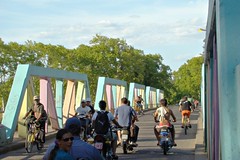Available in Spanish: Conociendo Tacuarembó
How did it cross our minds to go to Tacuarembó, in the depths of Uruguay, closer to the south of Brazil than to the Atlantic coast? It was a purely geographical matter: the goal was not to stay all the time in the coast, and not to return the same way we had come. Tacuarembó isn't a place of international tourist attractions, unless you're a true fan of Carlos Gardel (I'll explain that in due time).Anyway, Uruguay suffers from the same type of macrocephalic disorder as Argentina, only even more pronounced; if Buenos Aires and its metropolitan area hold between one third and one fourth of the Argentine population, half of the Uruguayan population (which is only one tenth of that of Argentina) is concentrated on the Montevideo Department. That is to say that all roads lead to Montevideo. Or, to make a long story short, there's no direct route from Rocha to Tacuarembó. The traveller who wants to reach the gaucho heart of the country has no other recourse but to go first west-southwest to Montevideo and then wait for another bus to take him north-northeast to Tacuarembó. You go to a place 365 km away (as the crow flies) but you have to travel some 560 km, including a few tens of kilometres going on the opposite direction as the one desired.
So despite our intentions we did go back on our steps, although our stay in Montevideo was much shorter; by a fortunate coincidence, the bus that took us away from a cool night in La Pedrera at 6:30 left us in Tres Cruces, Montevideo, four hours later, and less than an hour before the departure of the bus to Tacuarembó.
The trip was rather long: about five hours (that's long for Uruguayan standards). Half asleep, we entered a flat, green country of scattered cows and sheep. Map in hand, but with no real knowledge of actual geography, I tried to guess at and remember the names of towns and cities we were passing by. I knew we were going to cross several department capitals and a great river... We got to Durazno (what a beautiful name, I thought¹) and then, much later, when I'd started to lose hope of seeing running water ever again, I saw a bridge, a watery expanse, and bam, in a matter of seconds we'd crossed over a blue river, its banks lined with trees, and there waving at us was a huge yellow sign with the black silhouette of a bull, the mark of the most famous of tonic waters in both our countries (when I was little I believed "tonic water" was just a non-commercial way of saying Paso de los Toros).² Of course, of said tonic water only the brand is left, acquired by a multinational consortium which surely claims to be making it "with the same coolness as ever", or something like that.
¹ Durazno means "peach".Coming to Tacuarembó and getting off the bus was literally a thermal shock. From the marine coolness and the Montevidean air conditioning we had emerged directly into the subtropical weather of a land-locked city. And it was 4 PM, and in the Tacuarembó bus terminal there was no A/C. We went to the tourist office, where we were informed that touristic spots in Tacuarembó are located outside the city and in no way made easily accessible to visitors by bus.
² Paso de los Toros is the second city of Tacuarembó Department. Its name means "bulls' crossing", referring to the ford on the Río Negro beside which the city is located. It's also the brand name of a soft drink originally made there and still sold widely in Uruguay and Argentina.
Unraveled and sticky, we marched, backpacks over our shoulders, into the city center and towards our hotel, which turned out to be a curious but eventually satisfactory mix between disarray and amplitude. After the almost forgotten days in the confusing barracks that was the hostel of La Paloma, and the couple of days in the cozy but too little room in La Pedrera, with its doorless bathroom, this was paradise. We had a shower and, braving the awful heat outside, we went out for a walk.
Tacuarembó is a village — a village of fifty-odd thousand, scattered, but a little town anyway, with summer afternoons empty until sunset, lots of young guys in motorbikes, a big square in the middle, a main street on each side of the square and a church just over there. If even walking in the shade hadn't been exhausting, I'm sure we could've enjoyed it more. As things went, there wasn't much to see, so we took the road towards the only tourist attraction we could reach on foot, the Lavenders' Lagoon (Laguna de las Lavanderas).
Even if a picture is worth a thousand words, one has to note that those words can be lies. The postcard images of the Lavenders' Lagoon showed a beautiful watery mirror surrounded by greenery and shade; only by coming close you would notice that the calm water was in fact stagnant. There was indeed much life and green stuff there, but it felt yucky just thinking of touching the water with the tip of a toe.
We fled, therefore, and back in the city, after crossing a bridge painted in bright, desaturated colours (the multicolour logo of the Municipality of Tacuarembó), we got into a cybercafé, and after that we went looking for a place to eat. We shared a huge sandwich and a beer in a bar, sitting next to two young foreign tourists of Anglo-Saxon speech habits and backpacker looks, who for some strange reason (such is the way of globalization) had ended up in this same little corner of the planet as us.
We were in front of the main square, which was filling up, and beside the main street, buzzing with little motorbikes and scooters. I'm emphasizing the bikes because it seems to be a common feature of middle-sized towns where public transport is scarce or nonexistent; in Chilecito, La Rioja, we'd observed that each and every youth seemed to have a motorbike, small or big, old or new, but always a means of transportation for their own use, relatively small and inexpensive, so as to be free from the alternative of a long, slow walk vs. an expensive taxi.
In Tacuarembó, of course, the boys came in motorbikes or bicycles carrying their thermos and mate, showing a kind of manual dexterity I couldn't hope to imitate; they parked at the square, turned on their music, chatted and drank mate. None or almost none of beer or wine or alcoholic drinks, which in Argentina and in squares and in every public place where young people gather tend to mix and turn inevitably into insolence and violence. It was still early, sure, but these guys seemed to be ready to stay, and neither boys nor girls looked any less happy or entertained than their Argentine counterparts, who (rather sadly) claim or assume they need some alcohol blood content to have fun.
These observations having been made, and with a few good, cold glasses of beer in our bloodstream, we wrapped up dinner and went back to the hotel to have some rest.
To be continued...
















No comments:
Post a Comment
Note: Only a member of this blog may post a comment.